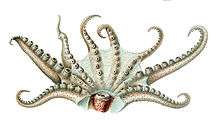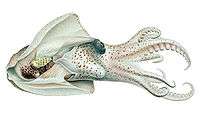Bolitaenidae
| Bolitaenids | |
|---|---|
 | |
| Female Bolitaena pygmaea from the Gulf of Guinea | |
 | |
| Female Japetella diaphana from northeastern São Tomé Island | |
| Scientific classification | |
| Kingdom: | Animalia |
| Phylum: | Mollusca |
| Class: | Cephalopoda |
| Order: | Octopoda |
| Suborder: | Incirrina |
| Family: | Bolitaenidae Chun, 1911 |
| Genera | |
|
Bolitaena | |
Bolitaenidae is a family of small, common pelagic octopuses found in all tropical and temperate oceans of the world. The family's taxonomy is not entirely certain; recent research suggests there should be just two genera, Bolitaena and Japetella, both of which are thought to be monotypic. Under this view, the family would represent two very similar species: Bolitaena pygmaea and Japetella diaphana.
Physical description
Bolitaenids are characterised by their small size—up to 8.5 centimetres or 3.3 inches mantle length and 12 centimetres total length in Japetella species—and their comparatively short arms, much shorter than their dome-shaped mantles. The arms have a single series of suckers; in males, these suckers are greatly enlarged on the third right arm. In Bolitaena (but not Japetella) this arm is also modified into a hectocotylus, an appendage used to facilitate transfer of spermatophores during mating.


Right: Dissected male Japetella diaphana
The eyes of both species are laterally compressed; they are distinctly smaller and set farther apart from the brain on longer optic stalks in Bolitaena than in Japetella—this feature may be the only way to differentiate the two genera when examining subadults. Mature males are rarely encountered. Their translucent, gelatinous bodies are fragile and easily damaged during collection.
Perhaps the most striking feature of the family is seen in mature females; upon maturity a ring-shaped photophore—a light-producing organ—develops to encircle the mouth. This is believed to be an adaptation to life in gloomy, deep ocean waters; the bioluminescent ring may help males and females to find each other.
Habitat
Mature bolitaenids occupy depths in the meso- to bathypelagic zones of the water column, down to about 1,425 metres. Younger animals (under 20 millimetres mantle length) are known to remain in shallower waters, either from 170-270 metres or 500-800 metres depending on size. Japetella is known to venture into far northern waters.
Reproduction
Mating is thought to occur at or below 1,000 metres depth. In the darkness, whether mating is successful or not may depend on the female; she can choose whether to signal the male with her circumoral photophore. The light emitted by the photophore is believed to be of a specific wavelength, possibly both preventing miscommunication and the attraction of predators.




After mating the female then rises to about 800 metres to brood. Her eggs are interconnected by a number of stalks; the whole mass is held safely by means of suckers near her mouth. Due to the cold (4–5°) environment, brooding likely takes several months; the female is thought to forgo food during this entire period. After hatching, the young octopuses rise to the productive, upper 300 metres of the water column where they remain until reaching a certain size (7–20 millimetres). As they mature the young begin their gradual descent to the mesopelagic and eventually bathypelagic zones.
Species

- Genus Bolitaena
- Bolitaena pygmaea
- Genus Japetella
- Japetella diaphana
External links
| Wikispecies has information related to: Bolitaenidae |
| The Wikibook Dichotomous Key has a page on the topic of: Bolitaenidae |